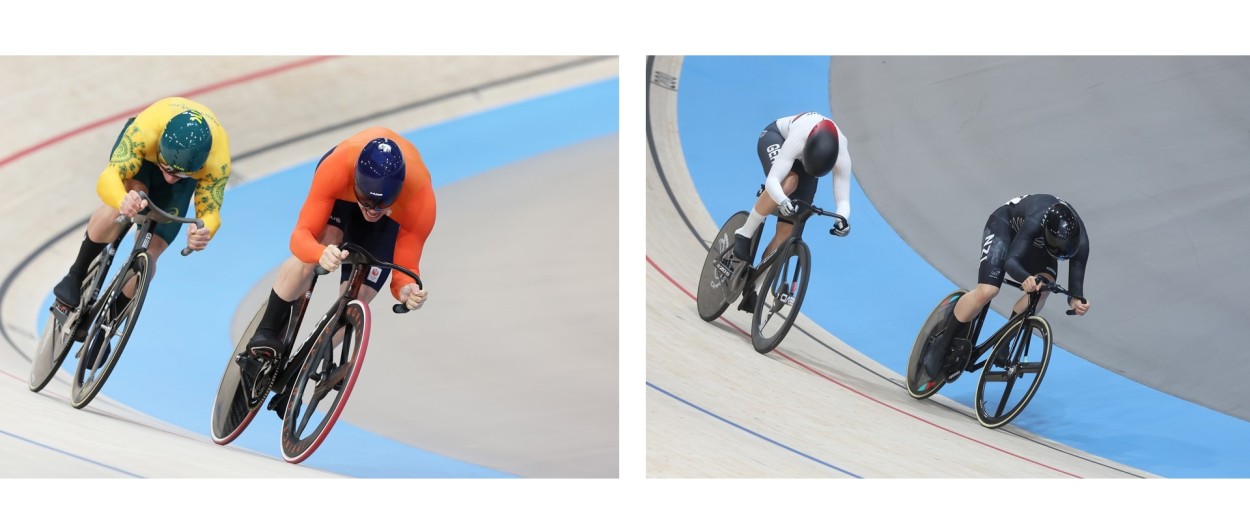Track cycling sprint is also a matter of strategy
 Individual sprint gold finals at the Paris 2024 Olympic Games. Left, Matthew Richardson (yellow) and Harrie Lavreysen (orange). Right, Lea Sophie Friedrich (white) and Ellesse Andrews (black). Credit: Patrick Pichon, FFC.
Individual sprint gold finals at the Paris 2024 Olympic Games. Left, Matthew Richardson (yellow) and Harrie Lavreysen (orange). Right, Lea Sophie Friedrich (white) and Ellesse Andrews (black). Credit: Patrick Pichon, FFC.
Track cycling spriit s one of the most popular events on the track. Although it is primarily a sprint where pure speed is paramount, strategy is a key factor in success. But quantifying it is a tricky task. This is the aim of work by Jean-François Rysman and his colleagues at the Hydrodynamics Laboratory (LadHyX*), in collaboration with the French Cycling Federation (FFC) as part of the Sciences2024 project.
The sprint competitions take place in two phases. The qualifying rounds are individual sprints over a distance of 200 meters, in which riders must achieve the best possible time (the women's and men's records are 10.029 seconds and 9.088 seconds respectively, both set at the Paris Olympics). Qualifiers then compete in one-on-one elimination matches. In these races, over three laps of the 750-meter track, the two cyclists start one behind the other - the choice is made by drawing lots. The first two laps often resemble a game of cat-and-mouse, with the leading cyclist frequently glancing over his shoulder to avoid being caught off guard by his opponent's sudden acceleration. The last 250 meters usually end in a final sprint.
Video analysis and predictive AI
LadHyx scientists were able to analyze around 1,500 videos from the FFC database, filmed during the World and European Championships, the World Cup and the Olympic Games between 2018 and 2024. “By extracting riders' positions at each lap, we can determine the influence of race configurations and the best strategies to adopt,” explains Jean-François Rysman, first author of the study. They were able to show that the starting position had no significant impact on the result. But, for example, if a rider is second after the first 115 meters, taking the lead on the 2nd lap leads to victory in 69% of cases.
To better quantify and prioritize the factors leading to victory, the researchers developed an artificial intelligence model trained on these 1,500 races. While speed over 200 meters is the most important parameter, strategy and race configuration (who is in the lead on which lap) also play a significant role. As a result, winners are not always those who set the fastest time in qualifying, like Ellesse Andrews, who won the women's gold medal at the Paris Olympics when finalist Lea Sophie Friedrich had been faster in qualifying.
Information for coaches and future athletes
This artificial intelligence model is also predictive, providing win probabilities based on the difference in speed over 200 m between two cyclists, race configuration and strategy. This model was applied retrospectively to the Paris Olympics races by making a prediction based on speeds achieved during qualifying and past match history, then simulating the competition 3000 times from the quarter-finals onwards, with different race configurations. According to this study, Harrie Lavreysen (Olympic champion in the men's event) had a 75% chance of winning gold after qualifying. In the women's race, the odds were closer (37% for Lea Sophie Friedrich versus 31% for Ellesse Andrews).
These analyses provide additional information for coaches and athletes, in addition to the many other factors to be considered (nutrition, physical parameters, stress management...). "For a cyclist, fine-tuning race strategies is a long-term task," emphasizes Jean François Rysman. I think our work will be particularly useful for aspiring top-level athletes currently in training."
The scientific article:
Rysman, J. F., Cohen, C., Sachet, I., Brunet, E., Baré, A., Baugé, G., … Clanet, C. (2025). Routes to victory in track cycling sprint. International Journal of Performance Analysis in Sport, 1–15. https://doi.org/10.1080/24748668.2025.2491999
*LadHyX: a joint research unit CNRS, École Polytechnique, Institut Polytechnique de Paris, 91120 Palaiseau, France
 Support l'X
Support l'X